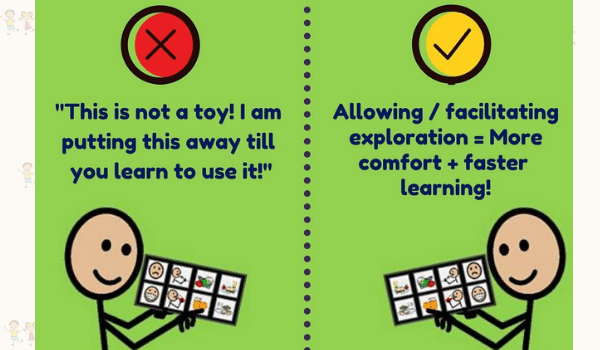Presuming competence is an AAC mantra we all have heard of. In this blog, I want to talk about how we put this important concept into practice.
What does Presuming Competence Really Mean?


Presuming competence means that we as communication partners assume that the communicator is capable of learning to communicate and build language. They may not have the capabilities now. But we believe that they can gain communication and language skills with the right support. So, we interact with them as we would with any other individual of similar age.
What Assumptions are We Making?
❌Maybe I’ll hand him/her a simple AAC system because they may not do well with a robust system ❌
When Professor Anne Donnellan in 1984 introduced the concept of presuming competence, she talked about making the least dangerous assumptions about individuals with disabilities when we don’t have enough data.
✅ This is why we provide an user with a robust AAC system. And model appropriate language without expectation.This is considered to be the best and safe approach ✅
The alternative to this will be to provide a simple system with fewer vocabulary. Assuming that a robust system is considered too complex for the user holds back their communication and language development. This is detrimental to the user’s progress.
No Prerequisites, No Proof
It’s common practice to expect the user to demonstrate some prerequisite skills. Interventionists can look for a good understanding of language, communicative intent, attention, and motivation to communicate before handing a robust AAC.
But can a communicator really demonstrate their potential when they lack the means to do so?
Expecting individuals to prove their skills and earn their right to a robust AAC system is unreasonable.
Mary-Louise Bertram , a special educator, argued that if we provide the same learning environment and opportunities and experiences that typical kids require to develop language, and if we provide quality instruction and create access to appropriate technology, kids having complex communication needs can access language.
Putting Presume Competence into Practice
Here are a few simple ways in which we can practise presuming competence with our communicators –
- Make AAC Available
Let’s presume that the child has a lot to say and will communicate when they have a means to do it.
Develop new habits such as always having the AAC device close by. Have the app in another device(like your phone, if possible) and have low tech versions of their vocabulary ready so that they have multiple modes to communicate.
- Don’t Infantilize AAC Users
Let’s presume that they are capable of comprehending new concepts.
Choose language and communication activities and materials that are age appropriate. Be age respectful. Remember that the activities should also fit in with their interests.
- Pause and be Patient
Let’s presume they are going to respond and let’s pause expectantly.
Let’s presume that if we are persistent and patient, we can see progress.
Communication is hard work for many AAC users. Let’s make it easier for them by
- Giving extra time to process the information you say
- Giving them adequate time to respond.
- Taking time everyday to practise AAC.
- Never trying to interpret what they are trying to tell us
- Know When to Step In and Step Back
Let’s presume that they are capable of doing better with the right support.
As and when needed, especially for an emergent user, try simple short sentences initially. Most users are strong visual learners. So, provide visual supports if necessary to help them learn.
Let’s presume they can communicate autonomously.
Emergent communicators may need other prompts and cues when they are beginning to learn a new skill. Follow the prompt hierarchy and be discreet about the help you are giving. Make sure your support does not come in their way of communication autonomy.
- Acknowledge the AAC User
Let’s’ presume that the AAC user can respond to you and have a social exchange.
Talk directly to the user rather than talking through someone else. This will make them want to participate in conversations and boosts their self confidence. Let them know what they say matters
Abundant language models,appropriate tools, your support and faith in their abilities helps them in achieving their communication potential. When we assume competence we show that we trust in their abilities. We try and this motivates the user to try too. No matter how complex their needs are, they are definitely tuned in when we show that we believe in them.
WRITTEN BY
Niveditha Ryali
Speech – Language – Swallowing Therapist
I have 16 years of learning experience that comes from working in NHS(UK), special schools, hospitals and private practice. I am passionate about working on improving Speech, Language and Swallowing skills in children and adults. I also strive to facilitate early communication in children with complex communication needs, thereby improving parent-child bonding.


References:
https://praacticalaac.org/strategy/strategy-of-the-month-engaging-the-learner/

